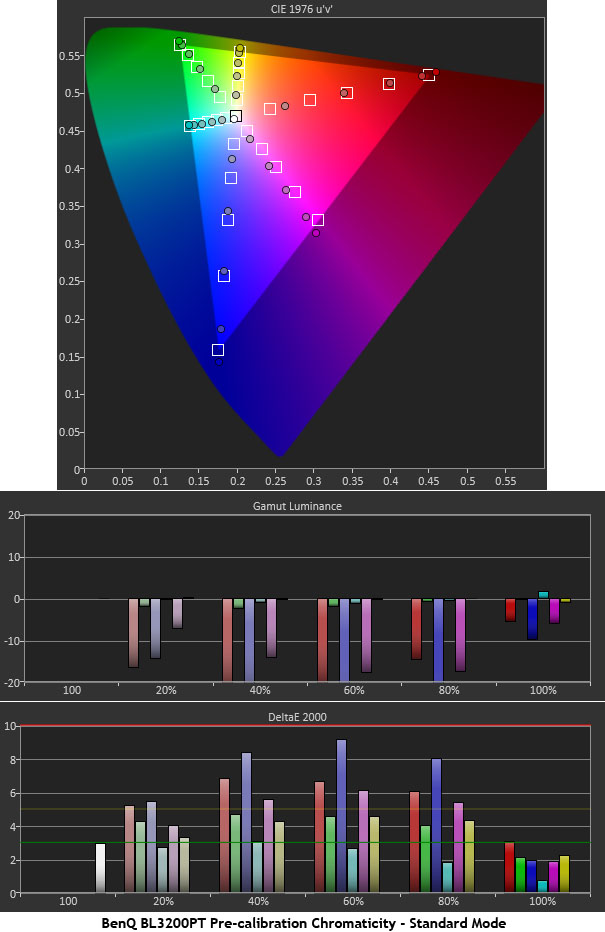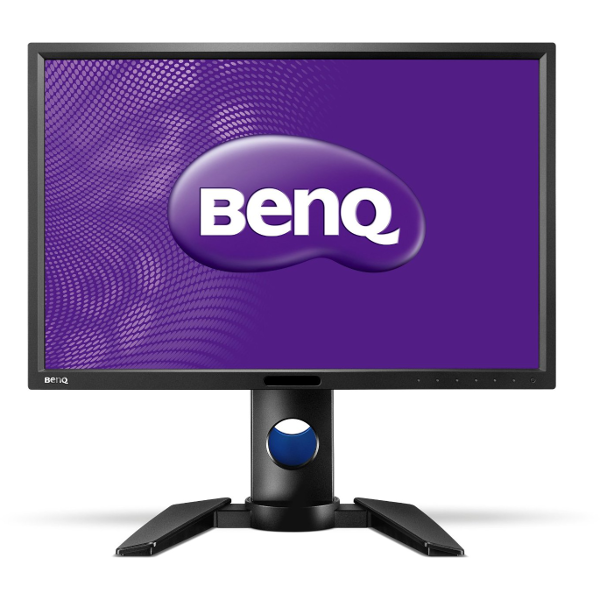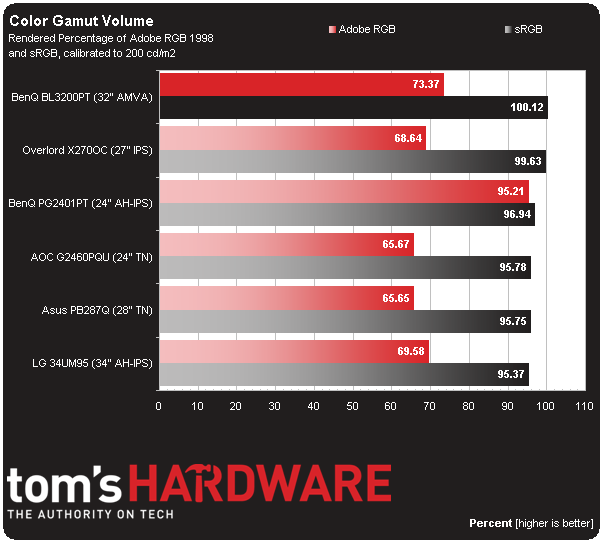BenQ BL3200PT Review: A 32-Inch AMVA Monitor At 2560x1440
The extra pixel density of a 27-inch monitor sporting a native 2560x1440 resolution can make small text difficult to read. BenQ solves the problem by adding five extra inches to its BL3200PT. Today we test this jumbo 32-inch AMVA-based panel in our lab.
Results: Color Gamut nd Performance
Color gamut is measured using a saturation sweep that samples the six main colors (red, green, blue, cyan, magenta, and yellow) at five saturation levels (20, 40, 60, 80, and 100%). It yields a more realistic view of color accuracy.
The out-of-box chroma results are interesting because they show how incorrect gamma can affect color saturation. If you look at the 100-percent points (the edge of the triangle), they’re pretty close to their targets. But the lower saturations are as much as 20 percent off the mark. For instance, 40-percent red is right on the 60-percent target. The net result is that the image looks oversaturated in most cases, even though gamut volume is essentially correct. There is a little compensation in the form of lower luminance values for red, magenta, and blue. Of course, what we want to see is for all saturation values to hit their respective targets.
Engaging the CAD/CAM preset worsens the saturation issues. Eighty- and 100-percent values are almost the same, meaning detail in the brightest parts of the image is nearly non-existent. Because of the cooler grayscale in this mode, the cyan and magenta secondaries are off in hue as well.
An instrumented calibration is the best way to set things right. The 20 to 80 percent levels in red, magenta, and blue are still a tad over-saturated, but the lowered luminance brings the actual error below three Delta E. The BL3200PT isn’t quite at the accuracy level of a factory-calibrated professional monitor, but it doesn’t cost nearly as much, either. Considering price versus screen size, this remains an excellent performer.
Now we return to the comparison group:
A 2.02 Delta E result may represent a last-place finish, but it’s still an invisible error. All of the monitors in our group offer great color accuracy, and you’d be hard-pressed to tell the difference in a side-by-side comparison.
Gamut Volume: Adobe RGB 1998 And sRGB
There are basically two categories of displays in use today: those that conform to the sRGB/Rec. 709 standard like HDTVs, and wide-gamut panels that show as much as 100 percent of the Adobe RGB 1998 spec. We use Gamutvision to calculate the gamut volume, based on an ICC profile created from our actual measurements.
Get Tom's Hardware's best news and in-depth reviews, straight to your inbox.
Before calibration, the BL3200PT’s sRGB gamut volume measured closer to 103 percent. While this isn’t a big deal in productivity or entertainment applications, photo and graphics users will want to calibrate for greater accuracy and a 100-percent volume. The main culprit is the blue primary, which is over-saturated at the Gamma 3 setting.
Current page: Results: Color Gamut nd Performance
Prev Page Results: Grayscale Tracking and Gamma Response Next Page Results: Viewing Angles and Uniformity
Christian Eberle is a Contributing Editor for Tom's Hardware US. He's a veteran reviewer of A/V equipment, specializing in monitors. Christian began his obsession with tech when he built his first PC in 1991, a 286 running DOS 3.0 at a blazing 12MHz. In 2006, he undertook training from the Imaging Science Foundation in video calibration and testing and thus started a passion for precise imaging that persists to this day. He is also a professional musician with a degree from the New England Conservatory as a classical bassoonist which he used to good effect as a performer with the West Point Army Band from 1987 to 2013. He enjoys watching movies and listening to high-end audio in his custom-built home theater and can be seen riding trails near his home on a race-ready ICE VTX recumbent trike. Christian enjoys the endless summer in Florida where he lives with his wife and Chihuahua and plays with orchestras around the state.
-
npyrhone "Remember that 92 ppi number we mentioned at the beginning of today's story? That seems to be a sweet spot. It works fine at 24 inches if your screen is FHD. You won’t discern individual pixels, but you’ll be quickly wishing for more screen real estate. Moving up to 2560x1440 at 27 inches increases density to 109 ppi. That’s great for gaming and photo work. However, text and small objects become difficult to see for many users."Reply
I can't understand why I would need a monitor with lower pixel density? Why not just zoom the text a notch in your word processor or whatever software you are using? Of two otherwise similar monitors I would always choose the one with higher PPI, even if I used it only for word processing. -
kid-mid I rather have the 27" QNIX Evo II 1440p for $300 or the ROG Swift for $600.Reply
The days of 60Hz are almost over with.. -
moogleslam ReplyI rather have the 27" QNIX Evo II 1440p for $300 or the ROG Swift for $600.
Except that the Swift cost $800
The days of 60Hz are almost over with.. -
Merry_Blind "The only complaint we’ve registered along the way involves font size. With a pixel density of 109 ppi, text in most Windows applications becomes pretty small."Reply
That's why I don't understand people saying 1080p is crap and has to go away. I've always find that even at 1080p, the fonts are really small, and icons and interfaces in general are very tiny. In my case, it's not even a case of not being able to read, it's just that everything looks so out of place and hideous, like, Windows wasn't meant for such resolutions.
I can't imagine 1440p. Must be ridiculous to look at. It's just aesthetically not nice.
Bring on the downvotes... -
animalosity Why in God's green earth would you pay $1000 for a 1440p display at 60hz when you can get a 4K for way less than that now. Rather have UHD....Reply -
Bondfc11 I agree with npyrhone - there are ways to enlarge everything on your screen if the density is too low. Having said that - this is an interesting panel. However, I cannot wait for the days when not TNs, but also IPS and VA panels (in large formats) become standard at 120Hz. The hertz do make a noticeable difference in everything you do on the screen.Reply -
ohim I`ll wait to see what Active Sync monitors will be able to do , an IPS with Active sync over a TN with 144hz.Reply -
Merry_Blind ReplyI`ll wait to see what Active Sync monitors will be able to do , an IPS with Active sync over a TN with 144hz.
What is Active Sync? -
Merry_Blind ReplyWhy in God's green earth would you pay $1000 for a 1440p display at 60hz when you can get a 4K for way less than that now. Rather have UHD....
It's not 1000$ though...







